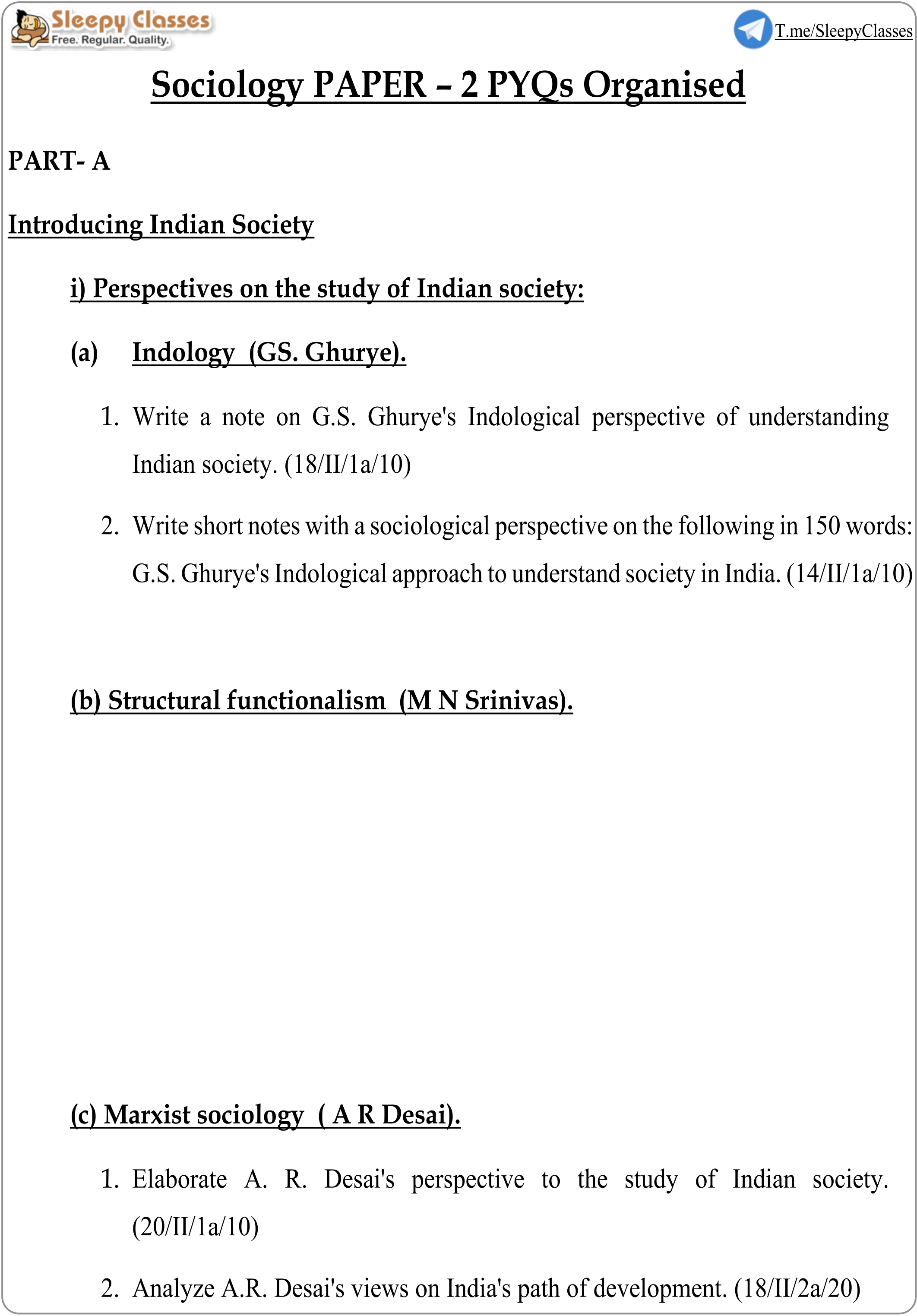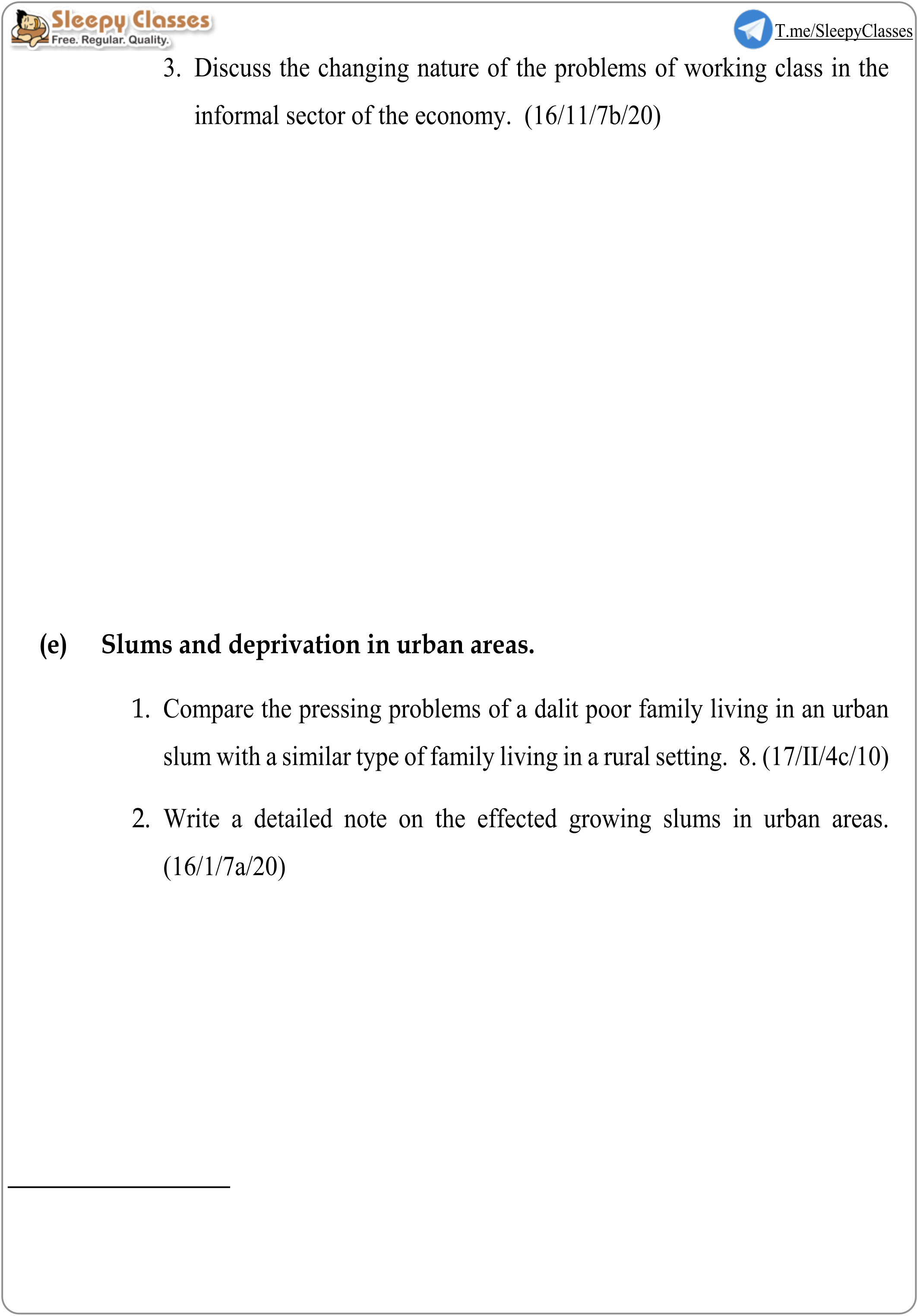Agrarian social structure evolution land tenure system
1.Elaborate Srinivas's views on religion and society among the Coorgs.
(19/II/1a/10)
2.Write a critique of the structural and functional perspective used by M.N. Srinivas in the understanding of Indian society. (17/II/1a/10) 3.Write short note with a sociological perspective: M.N. Srinivas's concept of westernisation. (150words) (13//II/1b/10)
 |
|---|
(19/II/3c/10)
A2
ii) Impact of colonial rule on Indian society:
(a ) Social background of Indian nationalism.
2.The main objectives of socio-religious movements during the colonial rule in India were reforming and synthesizing Hinduism. Write on any two such important movements. (17/II/2a/20)
3.Write short notes with a sociological perspective: Anti-Brahmanical movements during the colonial period. (16/II/10/10)
 |
|---|


PART- B
B1
(i) Rural and Agrarian Social Structure:
(a) The idea of Indian village and village
studies-
1.Critically examine Dube's contributions to the study of Indian
villages.
1.“Indian rural society is a faction-ridden society." Discuss. (20/II/2c/10) 2.Examine the changing initiatives of the land tenure system in India.
(19/II/1c/10)
3.Analyse the major components of Land Reform Acts. Show their effectiveness in curbing rural inequality. (16/II/2c/10)
4.Write short note with a sociological perspective: Jyotirao Phule as an agrarian
radical. (15/II/1b/10)
5.Describe the impact of land reforms on the peasants of Indian society. (14/II/4b/20)
1.How do you justify Dumont's deliberate stress on ideology that produced intellectualized account of Indian society? (20 / II / 1c / 10)
2.Write a note on Ghurye's conception of caste in India. (19 / II / 1d / 10)
| caste, | class | and | power | change | from |
|---|
5.Critically evaluate Louis Dumont's Homo Hierarchicus. (13 / II / 3b / 20)
6.What are the features of M.N. Srinivas' concept of dominant caste? How effective is it in understanding today's reality? (13
/ II / 3c / 10)
(b) Features of caste system.
 |
||
|---|---|---|
 |
/ 1a / 10)
10. Is caste system changing, weakening or disintegrating in India? (15 / II / 2a / 20)
4.Discuss B.R. Ambedkar as a wise democrat. (15 / II / 7a / 20)
5.Write some of the important social reforms in India for the removal of untouchability. (14 / II / 3c / 10)
Tribal Communities in India 

Tribal sub plan (TSP) (15/II/5b/10)
(b) Geographical spread
Illustrate with two examples from colonial and post independence
times. (17 / II / 4b / 20)
autonomy in modern India? (16 / II / 4a / 20)
2.What is ethno-nationalism? Examine the critical factors responsible


3.Why have we started using another category of tribes called the Particularly Vulnerable Tribal Groups (PVTGs)? Why are they so called? (17/II/ 8c / 10)
8.What are the features that distinguish tribes from the rest of the population? (13 / II / 2a / 20)
B4
(c) Middle classes in India.
1.How does Andra Beteille Justify ‘middle class in India? (20/II/3c/10)


(18/II/1d/10)
B5
System of Kinship in India
2.Broadly compare the kinship system of North and South India. (15 / II / 2c / 10)
3.Write short notes with a sociological perspective on the following in about 150 words Types of kinship systems in India (14 / ll / 1a / 10)
(c) Family and marriage in India.
1.What do you understand by LGBTQ? Comment on the issues concerning their marriage rights. (19 / II / 4c / 10)
3.Bring out the significance of the difference between family and household. (16 / II / 3a / 20)
4.Give some of the important studies relating to the structural changes in the Indian family system. (15 / Il / 2b / 20)
4.Write short notes with perspective: Patriarchy as dominance. a sociological form of a (16 / Il / le / 10)
6.Define Patriarchy. How does it impact the overall entitlement of a girl child in India? (14 / II / 2c / 10)
B6
3.Assess the impact of ban on "Triple Talak' on marriage and divorce among the Muslim community in India. (18/II/8c/10)
4.What are the distinct features of Islam as practised in India, and how have they changed over time? (17/II/1c/10)
9.Write a critical narrative on the concerns of religious minorities in India. (18/11/4b/20)
10. Elucidate the concepts of 'majoritarianism and 'minoritarianism' in accentuating communal tensions in India. (16/II/3b/20)
 |
|---|
PART- C
C1
3.Do you think that 'demonetization' has accelerated the economic growth in India ? How do you understand the informalization of labour, underemployment and gender discrimination in this context?
(19/II/7a/20)
(c) Education and social change.
1.How can skill development programme induce social change? Illustrate (20/II/6c10)
2.How does the New Education Policy, 2020 1 aim to eradicate disparities in the system of education in India? (20/II/5d/10) 3.Comment on the critical issues of commercialization of higher education in India. (19/II/5a/10)
4.Assess the role of the State in promoting education of girl child.(18/II/5d/10)
5. Write a note on Education and Equality in India. (17/II/5b/10) 6.Write short notes with a sociological perspective: Privatization of education and increasing inequalities. (16/II/5a/10)
7.Write short notes with a sociological 6. perspective: Empowerment through 'Right to Education'. (16/ II/5d/10)
8.Write short note with a sociological Perspective: Important components of National Education Policy in India. (15/II/5a/10) 9.Write short notes with a sociological perspective on the following in about 150 words: Impact of privatisation on educational disparities.
| (a) | of | rural | development, | Community |
|---|
3.How do the recommendations of Swaminathan Commission (2004-2006) ensure food and nutrition security for the Indian masses? (18 / I1 / 2c / 10)
4.Write short notes with a sociological perspective: Mahatma Gandhi
| National | Rural | Employment | Guarantee | Scheme | for |
|---|
(b) Green revolution and social change.
1.Has 'Green Revolution' led to the formation of new power elite in rural India? Elaborate your answer.(18 / II / 6b / 20)
 |
||
|---|---|---|
 |
(c) Changing modes of production in Indian agriculture .
1.Point out the benefits of 'green chemistry' for agrarian transformation in India. (20 / II / 5a / 10)
(d) Problems of rural labour, bondage, migration.
1.Discuss the dynamics of 'migrant workers' in India in the context of Corona pandemic. (20 / II / 3b / 20)
3.Elucidate the concerns of growing urban displacement dynamism in India. 5. (19/II/5e/10)
4.Examine the impact of heritage tourism urban socio-spatial patterns in India. (17/1/6b/20)
 |
|---|

4.Write short note with a sociological Perspective: Issues relating to the informal labor market in urban India. (15/II/5d/10)
4.Write an analytical note on slums in cities. (200 words) (13/II/7a/15)
C4
| 4.Comment | on | the | changing | democratic | profile | of |
|---|
(19/11/5d/20)
5.To what extent does nation building depend on strengthening of pluralities in Indian society? (17/II/7b/20)
3.Who are the elites? Discuss their roles in bringing social transformation. (14/II/8c/10)
(c) Regionalism and decentralization of power.
 |
||
|---|---|---|
 |





















